2019 Hyundai Ioniq Electric towing
[x] Cancel search: towingPage 63 of 526
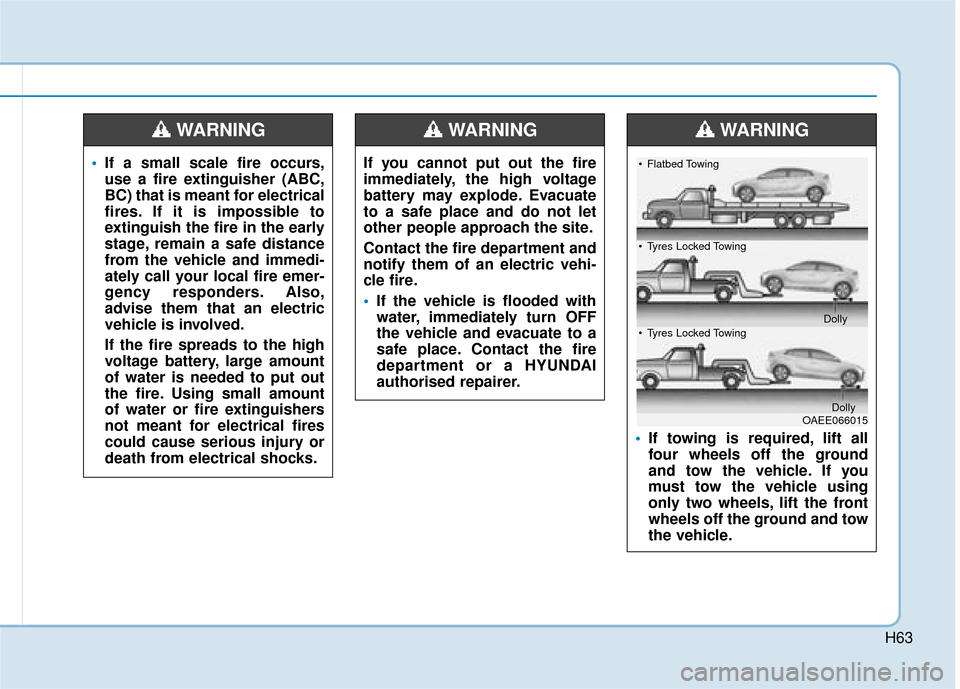
H63
If you cannot put out the fire
immediately, the high voltage
battery may explode. Evacuate
to a safe place and do not let
other people approach the site.
Contact the fire department and
notify them of an electric vehi-
cle fire.
If the vehicle is flooded with
water, immediately turn OFF
the vehicle and evacuate to a
safe place. Contact the fire
department or a HYUNDAI
authorised repairer.
WARNING
If towing is required, lift all
four wheels off the ground
and tow the vehicle. If you
must tow the vehicle using
only two wheels, lift the front
wheels off the ground and tow
the vehicle.
WARNING
OAEE066015
Flatbed Towing
Tyres Locked Towing
Dolly
Tyres Locked Towing
Dolly
If a small scale fire occurs,
use a fire extinguisher (ABC,
BC) that is meant for electrical
fires. If it is impossible to
extinguish the fire in the early
stage, remain a safe distance
from the vehicle and immedi-
ately call your local fire emer-
gency responders. Also,
advise them that an electric
vehicle is involved.
If the fire spreads to the high
voltage battery, large amount
of water is needed to put out
the fire. Using small amount
of water or fire extinguishers
not meant for electrical fires
could cause serious injury or
death from electrical shocks.
WARNING
Page 75 of 526

1-3
Your vehicle at a glance
1
E
EX
X T
TE
ER
R I
IO
O R
R
O
O V
VE
ER
R V
V I
IE
E W
W
(
( R
R E
EA
A R
R
V
V I
IE
E W
W )
)
1. Antenna ................................................4-2
2. Doors ....................................................3-8
3. Parking distance warning
(Reverse/Forward) system .................3-93
Parking distance warning (Reverse)
system ................................................3-91
4. Rear combination lamp ......................7-57
5. High mounted stop lamp ....................7-60
6. Rear view monitor ..............................3-90
7. Tailgate ...............................................3-33
8. Towing hook .......................................6-23
9. Normal/Fast charge ....................H20/H27
OAEE016002L
The actual shape may differ from the illustration.
Page 318 of 526
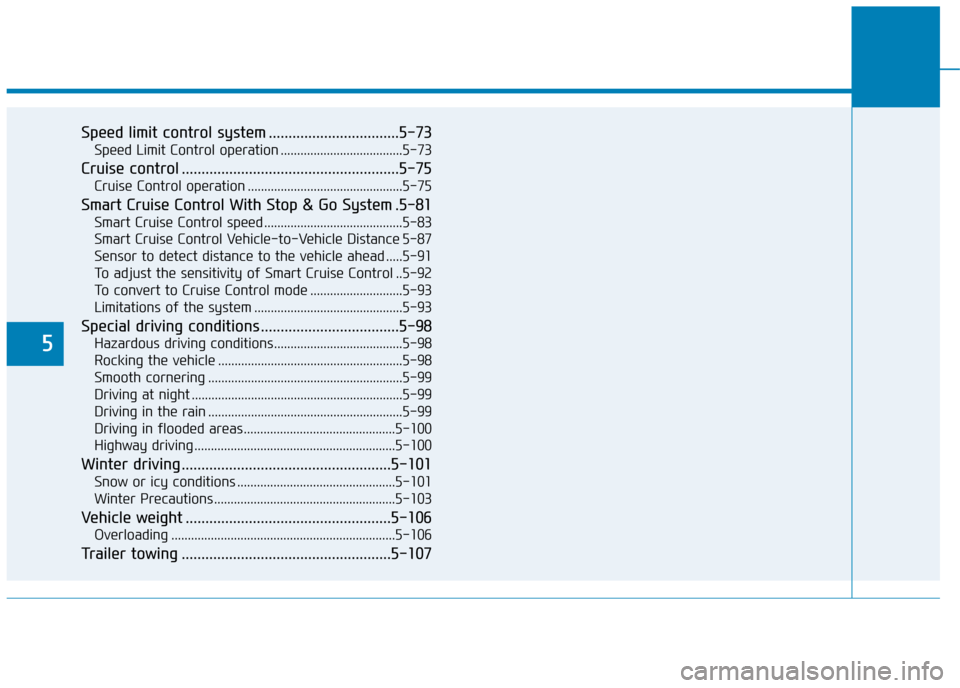
5
Speed limit control system .................................5-73
Speed Limit Control operation .....................................5-73
Cruise control .......................................................5-75
Cruise Control operation ...............................................5-75
Smart Cruise Control With Stop & Go System .5-81
Smart Cruise Control speed ..........................................5-83
Smart Cruise Control Vehicle-to-Vehicle Distance 5-87
Sensor to detect distance to the vehicle ahead .....5-91
To adjust the sensitivity of Smart Cruise Control ..5-92
To convert to Cruise Control mode ............................5-93
Limitations of the system .............................................5-93
Special driving conditions ...................................5-98
Hazardous driving conditions.......................................5-98
Rocking the vehicle ........................................................5-98
Smooth cornering ...........................................................5-99
Driving at night ................................................................5-99
Driving in the rain ...........................................................5-99
Driving in flooded areas..............................................5-100
Highway driving .............................................................5-100
Winter driving .....................................................5-101
Snow or icy conditions ................................................5-101
Winter Precautions .......................................................5-103
Vehicle weight ....................................................5-106
Overloading ....................................................................5-10\
6
Trailer towing .....................................................5-107
Page 375 of 526
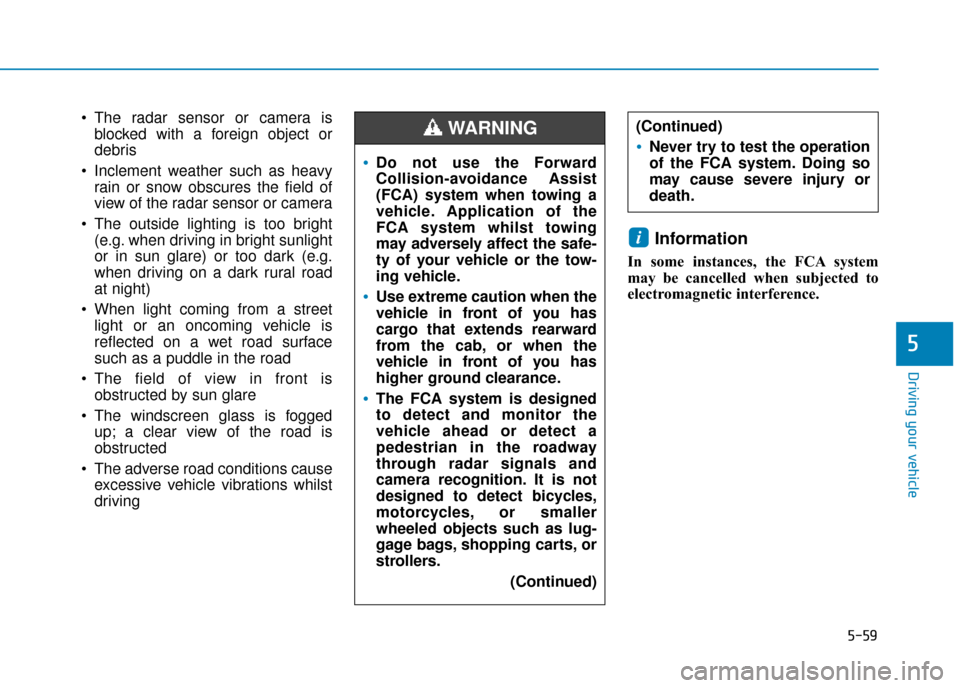
5-59
Driving your vehicle
5
The radar sensor or camera isblocked with a foreign object or
debris
Inclement weather such as heavy rain or snow obscures the field of
view of the radar sensor or camera
The outside lighting is too bright (e.g. when driving in bright sunlight
or in sun glare) or too dark (e.g.
when driving on a dark rural road
at night)
When light coming from a street light or an oncoming vehicle is
reflected on a wet road surface
such as a puddle in the road
The field of view in front is obstructed by sun glare
The windscreen glass is fogged up; a clear view of the road is
obstructed
The adverse road conditions cause excessive vehicle vibrations whilst
driving
Information
In some instances, the FCA system
may be cancelled when subjected to
electromagnetic interference.
i
Do not use the Forward
Collision-avoidance Assist
(FCA) system when towing a
vehicle. Application of the
FCA system whilst towing
may adversely affect the safe-
ty of your vehicle or the tow-
ing vehicle.
Use extreme caution when the
vehicle in front of you has
cargo that extends rearward
from the cab, or when the
vehicle in front of you has
higher ground clearance.
The FCA system is designed
to detect and monitor the
vehicle ahead or detect a
pedestrian in the roadway
through radar signals and
camera recognition. It is not
designed to detect bicycles,
motorcycles, or smaller
wheeled objects such as lug-
gage bags, shopping carts, or
strollers.
(Continued)
(Continued)
Never try to test the operation
of the FCA system. Doing so
may cause severe injury or
death.
WARNING
Page 415 of 526
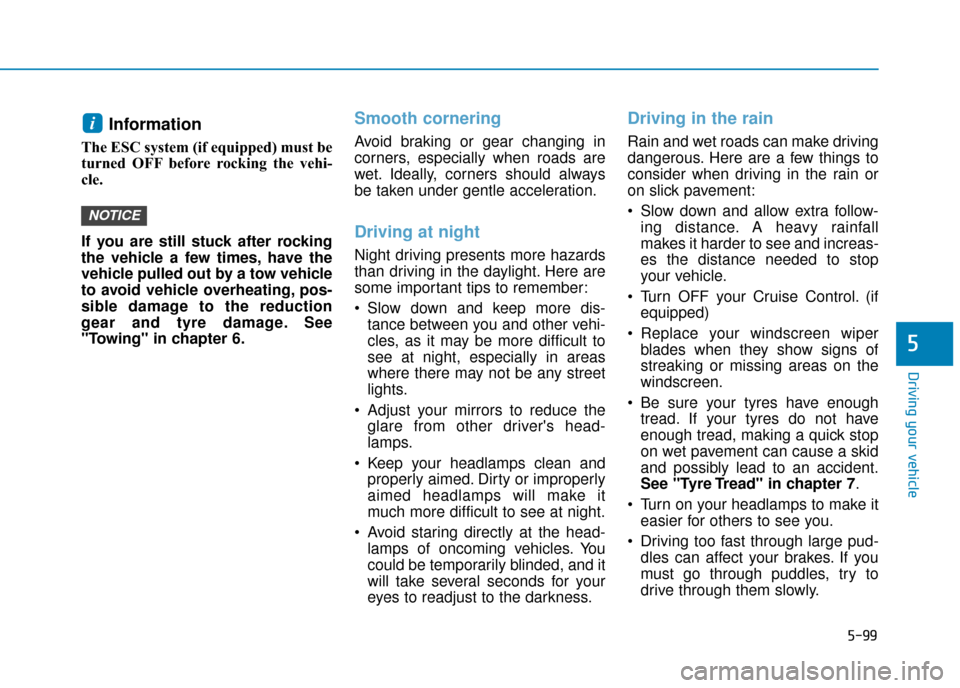
5-99
Driving your vehicle
5
Information
The ESC system (if equipped) must be
turned OFF before rocking the vehi-
cle.
If you are still stuck after rocking
the vehicle a few times, have the
vehicle pulled out by a tow vehicle
to avoid vehicle overheating, pos-
sible damage to the reduction
gear and tyre damage. See
"Towing" in chapter 6.
Smooth cornering
Avoid braking or gear changing in
corners, especially when roads are
wet. Ideally, corners should always
be taken under gentle acceleration.
Driving at night
Night driving presents more hazards
than driving in the daylight. Here are
some important tips to remember:
Slow down and keep more dis-tance between you and other vehi-
cles, as it may be more difficult to
see at night, especially in areas
where there may not be any street
lights.
Adjust your mirrors to reduce the glare from other driver's head-
lamps.
Keep your headlamps clean and properly aimed. Dirty or improperly
aimed headlamps will make it
much more difficult to see at night.
Avoid staring directly at the head- lamps of oncoming vehicles. You
could be temporarily blinded, and it
will take several seconds for your
eyes to readjust to the darkness.
Driving in the rain
Rain and wet roads can make driving
dangerous. Here are a few things to
consider when driving in the rain or
on slick pavement:
Slow down and allow extra follow-ing distance. A heavy rainfall
makes it harder to see and increas-
es the distance needed to stop
your vehicle.
Turn OFF your Cruise Control. (if equipped)
Replace your windscreen wiper blades when they show signs of
streaking or missing areas on the
windscreen.
Be sure your tyres have enough tread. If your tyres do not have
enough tread, making a quick stop
on wet pavement can cause a skid
and possibly lead to an accident.
See "Tyre Tread" in chapter 7 .
Turn on your headlamps to make it easier for others to see you.
Driving too fast through large pud- dles can affect your brakes. If you
must go through puddles, try to
drive through them slowly.
NOTICE
i
Page 423 of 526
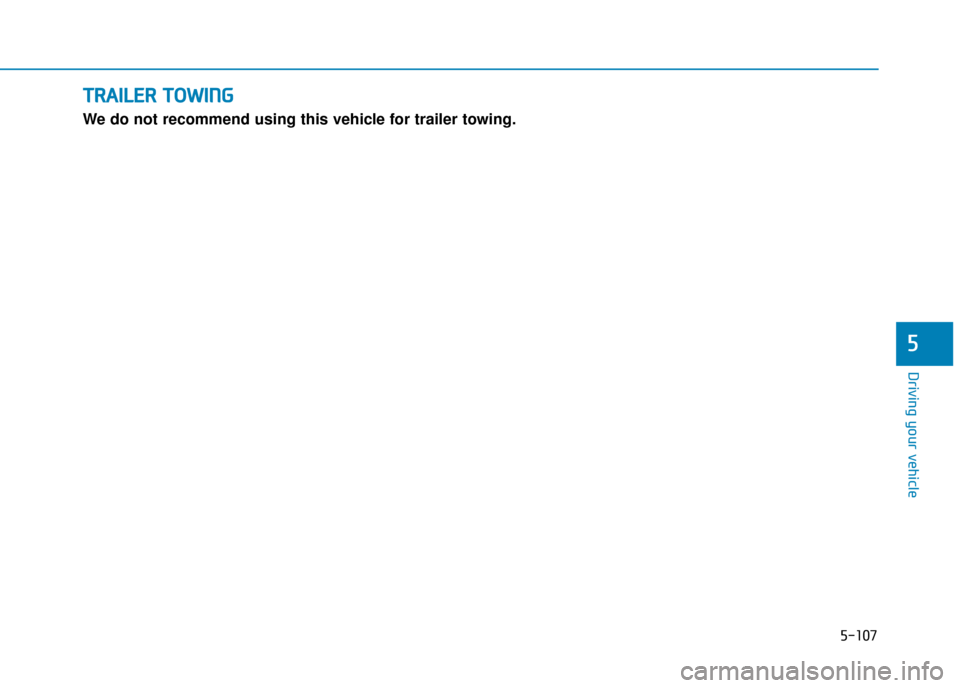
T
TR
R A
A I
IL
L E
E R
R
T
T O
O W
W I
IN
N G
G
We do not recommend using this vehicle for trailer towing.
Driving your vehicle
5-107
5
Page 424 of 526

What to do in an emergency
In case of an emergency whilst driving .............6-2
Hazard warning flasher ........................................6-2
If the vehicle stalls whilst driving..................................6-2
If the vehicle stalls at a crossroad or crossing .........6-2
If you have a flat tyre whilst driving ...........................6-3
If the vehicle will not start ...................................6-4
If the vehicle doesn't turn over or
turns over slowly .............................................................6-4
Jump starting (12V battery) .................................6-4
If the vehicle overheats ........................................6-8
Tyre Pressure Monitoring System (TPMS) ........6-9
Check tyre pressure .........................................................6-9
Tyre pressure monitoring system ...............................6-10
Low tyre pressure telltale.............................................6-11
Low tyre pressure position and
tyre pressure telltale ......................................................6-11
TPMS (Tyre Pressure Monitoring System)
malfunction indicator .....................................................6-12
Changing a tyre with TPMS .........................................6-13
If you have a flat tyre ........................................6-15
With Tyre Mobility Kit (TMK) .......................................6-15
Towing ...................................................................6-22
Towing service .................................................................6-22
Removable towing hook ................................................6-23
Emergency towing ..........................................................6-24
6
Page 427 of 526
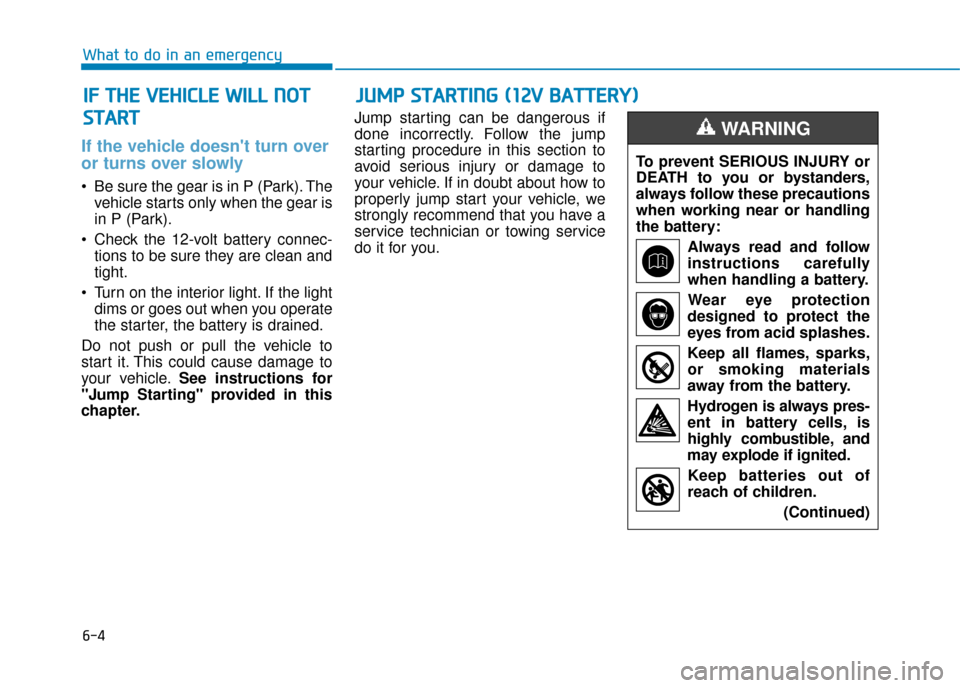
6-4
What to do in an emergency
If the vehicle doesn't turn over
or turns over slowly
Be sure the gear is in P (Park). Thevehicle starts only when the gear is
in P (Park).
Check the 12-volt battery connec- tions to be sure they are clean and
tight.
Turn on the interior light. If the light dims or goes out when you operate
the starter, the battery is drained.
Do not push or pull the vehicle to
start it. This could cause damage to
your vehicle. See instructions for
"Jump Starting" provided in this
chapter. Jump starting can be dangerous if
done incorrectly. Follow the jump
starting procedure in this section to
avoid serious injury or damage to
your vehicle. If in doubt about how to
properly jump start your vehicle, we
strongly recommend that you have a
service technician or towing service
do it for you.
J J
U
U M
M P
P
S
S T
T A
A R
RT
TI
IN
N G
G
(
( 1
1 2
2V
V
B
B A
A T
TT
TE
ER
R Y
Y )
)
I
I F
F
T
T H
H E
E
V
V E
EH
H I
IC
C L
LE
E
W
W I
IL
L L
L
N
N O
O T
T
S
S T
T A
A R
RT
T
To prevent SERIOUS INJURY or
DEATH to you or bystanders,
always follow these precautions
when working near or handling
the battery:
Always read and follow
instructions carefully
when handling a battery.Wear eye protection
designed to protect the
eyes from acid splashes.
Keep all flames, sparks,
or smoking materials
away from the battery.
Hydrogen is always pres- ent in battery cells, is
highly combustible, and
may explode if ignited.
Keep batteries out of
reach of children.
(Continued)
WARNING